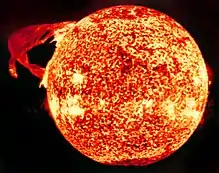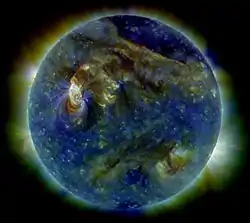Space Weather Follow-On L1
Space Weather Follow On-Lagrange 1 (SWFO-L1) is a future spacecraft mission planned to monitor signs of solar storms, which may pose harm to Earth's telecommunication network. The spacecraft will be operated by the National Oceanic and Atmospheric Administration (NOAA), with launch scheduled for February 2025.[1][2] It is planned to be placed at the Sun–Earth L1 Lagrange point, a location between the Earth and the Sun. This will allow SWFO-L1 to continuously watch the solar wind and energetic particles heading for Earth. SWFO-L1 is an ESPA Class Spacecraft, sized for launch on an Evolved Expendable Launch Vehicle Secondary Payload Adapter (ESPA) Grande ring in addition to the rocket's primary payload.[1] The spacecraft's Solar Wind Instrument Suite (SWIS) which includes three instruments will monitor solar wind, and the Compact Coronagraph (CCOR) will monitor the Sun's surroundings to image coronal mass ejection (CME).[1] A CME is a large outburst of plasma sent from the Sun towards interplanetary space.
| Names | SWFO-L1 |
|---|---|
| Mission type | Space weather |
| Operator | NOAA |
| Start of mission | |
| Launch date | February 2025 |
| Rocket | Falcon 9 Block 5 |
| Launch site | Cape Canaveral, SLC-40 |
| Contractor | SpaceX |
| Orbital parameters | |
| Reference system | Geocentric orbit |
| Regime | L1 |
| Instruments | |
| Solar Wind Instrument Suite (SWIS) Magnetometer Solar Wind Plasma Sensor (SWiPS) | |
Space Weather Follow-On Program | |
Together with space weather observation capabilities on the Earth-orbiting GOES-U satellite, SWFO-L1 constitutes the space segment of NOAA's Space Weather Follow-On (SWFO) program. The aim of the SWFO program is to ensure the robust continuity of space-based measurement of the critical space weather environment.[3][4] All of the spacecraft located in L1 which are currently monitoring CMEs and the solar wind have operated beyond their design lifetime. The Advanced Composition Explorer (ACE) is expected to consume its remaining propellant around 2024. Deep Space Climate Observatory (DSCOVR), NOAA's primary solar wind monitor, was launched in 2015 with a five year design lifetime. The European Space Agency-NASA Solar and Heliospheric Observatory (SOHO) will cease operation before the mid-2020s.[5] SWFO-L1's SWIS instruments will replace ACE's and DSCOVR's monitoring of solar wind, energetic particles and the interplanetary magnetic field while CCOR will replace SOHO's LASCO (Large Angle and Spectrometric Coronagraph) imaging of CMEs.[1]
Instruments
In April 2020, Southwest Research Institute (SwRI) was awarded a contract to supply SWFO-L1's magnetometer instrument.[6]
On 1 July 2020, on behalf of NOAA, NASA has awarded the Space Weather Follow On-Lagrange 1 (SWFO-L1) Solar Wind Plasma Sensor (SWiPS) contract to Southwest Research Institute (SwRI) in San Antonio, Texas. SwRI was awarded a contract with a total value of US$16 million. The period of performance is 76 months. SWFO-L1 will provide NOAA with the continuity of solar wind data and coronal mass ejection imagery, the National Weather Service's highest priority for space weather observations. The SWFO-L1 satellite, which is planned to launch as a rideshare with the NASA Interstellar Mapping and Acceleration Probe (IMAP), will collect upstream solar wind data and coronal imagery to support NOAA's mission to monitor and forecast space weather events. NOAA is responsible for the Space Weather Follow-On project. NASA is the program's flight system procurement agent, and NASA's Goddard Space Flight Center in Greenbelt, Maryland, is the lead for this acquisition.[7]
Launch
Space Weather Follow On-Lagrange 1 is planned to be launched as a secondary payload on the SpaceX Falcon 9 launch vehicle carrying NASA's Interstellar Mapping and Acceleration Probe (IMAP) spacecraft.[8][9] As of December 2020, the launch is scheduled for February 2025.[1][8][2]
References
- Ullman, Richard (26 June 2019). "NOAA's Current and Future Space Weather Observational Architecture" (PDF). Office of the Federal Coordinator for Meteorology. Retrieved 16 October 2019.
 This article incorporates text from this source, which is in the public domain.
This article incorporates text from this source, which is in the public domain. - "NASA Confirms New SIMPLEx Mission Small Satellite to Blaze Trails Studying Lunar Surface". NASA. 2 December 2020. Retrieved 4 December 2020.
 This article incorporates text from this source, which is in the public domain.
This article incorporates text from this source, which is in the public domain. - Talaat, Elsayed (4 April 2019). "NOAA's Current and Future Space Weather Architecture" (PDF). Space Weather Prediction Center. Retrieved 16 October 2019.
 This article incorporates text from this source, which is in the public domain.
This article incorporates text from this source, which is in the public domain. - Onsager, Terry. "NOAA's Space Weather Plans" (PDF). Space Weather Prediction Center. Retrieved 16 October 2019.
 This article incorporates text from this source, which is in the public domain.
This article incorporates text from this source, which is in the public domain. - Werner, Debra (6 March 2019). "Are small satellites the solution for space weather monitoring?". SpaceNews. Retrieved 13 October 2019.
- "NOAA's Space Weather Follow-On Lagrange 1 Magnetometer Awarded" (Press release). NOAA. 15 April 2020. Retrieved 28 April 2020.
 This article incorporates text from this source, which is in the public domain.
This article incorporates text from this source, which is in the public domain. - "NASA Awards NOAA's Space Weather Follow On-Lagrange 1 Solar Wind Plasma Sensor". NOAA. 1 July 2020. Retrieved 6 February 2021.
 This article incorporates text from this source, which is in the public domain.
This article incorporates text from this source, which is in the public domain. - "NASA Selects Proposals to Further Study the Fundamental Nature of Space" (Press release). NASA. 13 August 2019. Retrieved 9 October 2019.
 This article incorporates text from this source, which is in the public domain.
This article incorporates text from this source, which is in the public domain. - "NASA Awards Launch Services Contract for IMAP Mission" (Press release). NASA. 25 September 2020. Retrieved 25 September 2020.
 This article incorporates text from this source, which is in the public domain.
This article incorporates text from this source, which is in the public domain.

